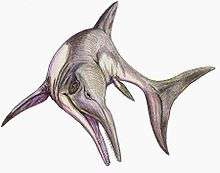Platypterygius
| Platypterygius Temporal range: Early - Late Cretaceous | |
|---|---|
 | |
| P. americanus | |
| Scientific classification | |
| Kingdom: | Animalia |
| Phylum: | Chordata |
| Class: | Sauropsida |
| Order: | Ichthyosauria |
| Family: | Ophthalmosauridae |
| Subfamily: | Platypterygiinae |
| Genus: | Platypterygius von Huene, 1922 |
| Species | |
Platypterygius is an ichthyosaur of the family Ophthalmosauridae. It is most closely related to the genera Caypullisaurus and Brachypterygius.[2]
Description

Platypterygius reached a length of about 7 m (23 ft). It had a long snout and a powerful finned tail. There are more digits in the front flippers than is usual in ichthyosaurs; they are tightly bound in rows, giving a broad, flat appearance . This unusual characteristic gives the genus its name, meaning 'flat wing.' Furthermore, some of the wrist bones have disappeared entirely. CAT scans on a juvenile specimen strongly suggest that Platypterygius was deaf.
Discovery and species
Fossils are known from Australia, Russia, United States of America, Colombia,[3] southern Patagonia,[4] Western Europe and possibly New Zealand. There are eight named species. Both adults and juveniles have been unearthed, including newborns and pregnant females which indicate that, like other ichthyosaurs, Platypterygius gave live birth.
The remains from Australia were originally called Ichthyosaurus australis. They are from the Toolebuc Formation and Allaru Mudstone (Albian, Lower Cretaceous) of Flinders River and other localities in north central Queensland. In 1990 Wade erected the species name P. longmani to include all remains previously referred to I. australis.
Classification

The cladogram below follows the topology from a 2010 analysis by Patrick S. Druckenmiller and Erin E. Maxwell.[5]
| Thunnosauria |
| ||||||||||||||||||||||||||||||||||||||||||||||||||||||||||||||||||||||||
| |
Palaeobiology

P. australis has been found with remains of sea turtles and birds (Nanantius) in its guts.[7] Several species attributed to this genus do indeed appear to be apex predators, specialised to hunting proportionally large prey.[8]
Species
- Platypterygius platydactylus (Broilli, 1907) (type)
- Platypterygius americanus Nace, 1939
- Platypterygius australis McCoy, 1867
- Platypterygius hautali von Huene, 1927
- Platypterygius hercynicus Kuhn, 1946
- Platypterygius kiprijanoffi Romer, 1968
- Platypterygius ochevi Arkhangel’sky et al., 2008
- Platypterygius sachicarum Páramo, 1997
Formerly referred species
- Pervushovisaurus bannovkensis Arkhangelsky, 1998[9]
- Pervushovisaurus campylodon Carter, 1846[10]
- Simbirskiasaurus birjukovi Otschev and Efimov, 1985[9]
- Plutonisaurus bedengensis Efimov, 1997
- Ichthyosaurus steleodon Bogolobov, 1909
See also
References
- ↑ Arkhangel’sky, M. S., Averianov, A. O., Pervushov, E. M., Ratnikov, V. Yu, and Zozyrev, N. Yu., 2008, On ichthyosaur remains from the Cretaceous of the Voronezh region: Paleontological Journal, v. 42, n. 3, p. 287-291.
- ↑ Fernández M. 2007. Redescription and phylogenetic position of Caypullisaurus (Ichthyosauria: Ophthalmosauridae). Journal of Paleontology 81 (2): 368-375.
- ↑ Páramo, M. E. Platypterygius sachicarum (Reptilia, Ichthyosauria) nueva especie del Cretácico de Colombia. Revista Ingeominas 6, 1997: 1–12
- ↑ Pardo-Pérez, Judith; Frey, Eberhard; Stinnesbeck, Wolfgang; Fernández, Marta S.; Rivas, Luis; Salazar, Christian; Leppe, Marcelo (2012). "An ichthyosaurian forefin from the Lower Cretaceous Zapata Formation of southern Chile: implications for morphological variability within Platypterygius" (PDF). Palaeoclimate, Palaeobiology, Paleoenvironments. 92: 287–294. doi:10.1007/s12549-012-0074-8. Retrieved 30 August 2016.
- ↑ Patrick S. Druckenmiller and Erin E. Maxwell (2010). "A new Lower Cretaceous (lower Albian) ichthyosaur genus from the Clearwater Formation, Alberta, Canada". Canadian Journal of Earth Sciences. 47 (8): 1037–1053. Bibcode:2010CaJES..47.1037D. doi:10.1139/E10-028.
- 1 2 Arkhangel’sky, M. S., 1998, On the Ichthyosaurian Genus Platypterygius: Palaeontological Journal, v. 32, n. 6, p. 611-615.
- ↑ Kear, Benjamin P.; Boles, Walter E. & Smith, Elizabeth T. (2003): Unusual gut contents in a Cretaceous ichthyosaur. Proceedings of the Royal Society B (Supplement) 270: S206–S208. doi:10.1098/rsbl.2003.0050
- ↑ Fischer, Valentin; Bardet, Nathalie; Benson, Roger B. J.; Arkhangelsky, Maxim S.; Friedman, Matt. "Extinction of fish-shaped marine reptiles associated with reduced evolutionary rates and global environmental volatility". Nature Communications. 7. doi:10.1038/ncomms10825.
- 1 2 Fischer, Valentin; Arkhangelsky, Maxim S.; Naish, Darren; Stenshin, Ilya M.; Uspensky, Gleb N.; Godefroit, Pascal (2014). "Simbirskiasaurus and Pervushovisaurus reassessed: implications for the taxonomy and cranial osteology of Cretaceous platypterygiine ichthyosaurs.". Zoological Journal of the Linnean Society. 171 (4): 822–841. doi:10.1111/zoj.12158.
- ↑ Fischer, V. (2016). "Taxonomy of Platypterygius campylodon and the diversity of the last ichthyosaurs.". PeerJ. 4: e2604.
- Long, J.A., Dinosaurs of Australia and New Zealand, UNSW Press, Australia 1998